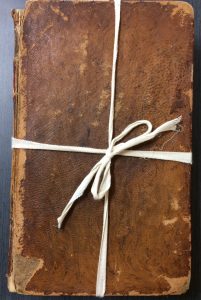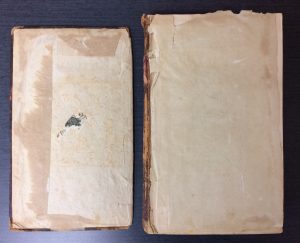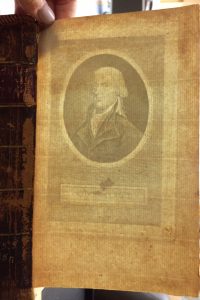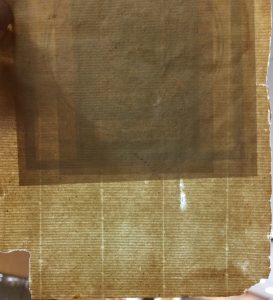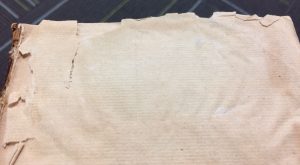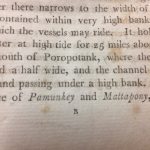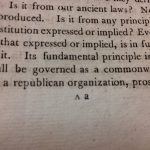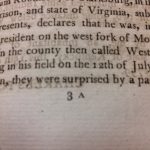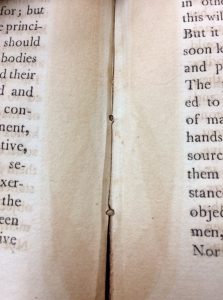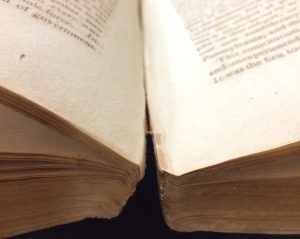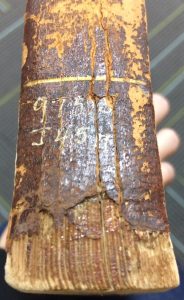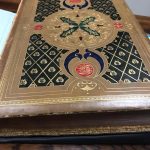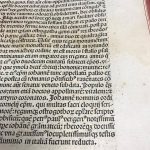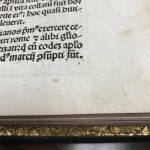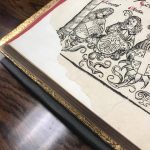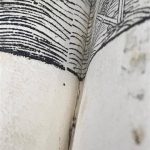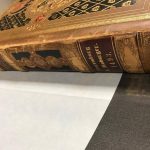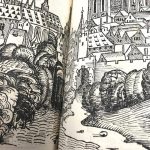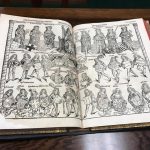“These weren’t cheap modern books; these were books bound in leather, and not just leather, but leather from clever cows who had given their lives for literature after a happy existence in the very best pastures.”
― Terry Pratchett, I Shall Wear Midnight
Books are not always just the thoughts contained within the text on their pages. To many, a book is the physical object itself, the smell of the binding, and the rustle of pages when they turn. While perhaps not everything is as idealistic as Pratchett’s quote above, it is true that there is a lot that goes into the physical creation of a book whether we are discussing the era of hand illuminated manuscripts, hand-pressed books, or more modern presses.
Philip Gaksell’s A New Introduction to Bibliography is an incredibly detailed account of making the physical body of a book in the hand-press era, from the 16th century to the early 19th. Everything is efficiently laid out from the making of paper and ink to the pressing of individual pages to the binding process. Books produced during this period are full of traces and marks from these various processes that are to books what scars, tan lines, and wrinkles are to us; they serve as a roadmap as to the origins of a particular book.
Tuesday morning presented the opportunity for me to perform this type of analysis on a book of my choosing. Since there is a more modern (20th century) binding on the A priest to the temple, I decided to find another book printed in the hand-press era. I chose a copy of the eighth edition of the uniformly titled Poems. Selections( officially titled as Poems, Ect. written upon several occasions, and to several persons) by Edmund Waller, Esq.
Basic Information:
This copy of Poems. Selections is one from the eighth edition printed with slight revisions and a summary of the author’s life. On the title page (Fig. 1) it states that the Shakespear’s Head (their spelling, not mine) “over against
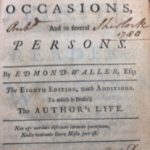
Fig. 1: Title page with inscriptions
Catherine street in the Strand” printed the book for Jacob Tonson (although I think it possible that the first “n” is an “m” that did not get enough ink which would make the last name Tomson) in 1711. Also to be found on both sides of the title page is provenance. There is one inscription written in 1992 and another inscribed to a “Sherlock” in 1780. On the back side of the title page is a longer inscription to a lieutenant in 1792. (Fig. 2) Other small markings adorn the book in places, but they are either illegible or smudged such that I could not read them.
What is truly fascinating is that when I looked into some of the history of the Shakespear’s Head, I found that A. H. Bullen and Frank Sidgwick established the press in 1904. Yet the title page clearly states that this copy was printed in 1711. I did consider the possibility that perhaps the original collection of poems was published in 1711, with this copy having been printed much later, but there is no note of that in the book. In addition, checking the Special collections record of the book, it is listed as having been printed in 1711. I will be investigating this further with the help of our archivists.
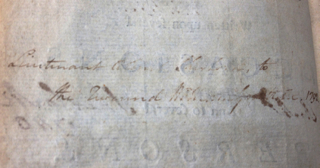
Fig. 2: Inscription on back of title page.
Cosmetic Information/Observations:
As is normal for the time, the book is bound in some sort of leather, most likely tanned calf-skin, although I cannot say for sure. On both the front and back covers the binder tooled in a blind design decorated with flowers at the corners. (Fig. 3) An alternate title for the book, Waller’s Poems, is tooled in gilt on the spine (Fig. 4) which speaks to it’s publication date. Books at this point would have been facing spine outward on a shelf rather than fore-edge out, and so the gilt title would have been necessary to identify the book.
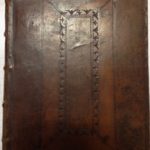
Fig. 3: Front cover of the book; shows blind tooling done in the leather.
The cover is beginning to wear along both sides of the spine and darker splotches are scattered along both covers. It is possible that this is some beginning stage of red-rot, but given the care taken by the Special Collections department, I suspect it has either been treated to stop the process, or it is simply old age. Several cracks and cress also adorn the spine, and one can clearly see the five cords that each gathering was sown onto. (I always wondered when looking at older books what the ridges along the spine were, and it delighted me to find out that rather than merely being decorative, they hold the book together and can only be seen due to the process of tightly stretching the leather over the cover boards.) Foxing can be found on the top, bottom, and fore-edge (Fig. 5) of the book with the only difference being that the top-head is darker than the other too due to an accumulation of dust. Also noticeable is that along the top edge one can see where the cords have been stitched to the gatherings in three places, and by studying the fore-edge it becomes clear that the paper was cut, for the edges are clear and not feathery.
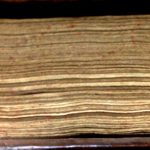
Fig. 5: Example of foxing along the fore-edge of the book.
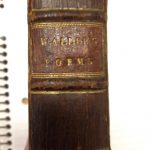
Fig. 4: Spine of book complete with detail of gilt title and evidence of cords.
Opening the book offered a new wealth of information. The edges of pages had yellowed and one could feel the slightly rough texture of the pages. Small flecks of brown from color differences in the paper pulp, or stuff, scatter themselves through the pages, which do become more rough as one gets to the middle of the book. one can also tell easily that the endpapers are made of a different quality of paper as they have a different texture and have not yellowed as much as the other pages. Opening to the front cover, one finds the watermark (Fig. 6) and also impressions of the strips used to connect the cover boards to the manuscript. So far I have been unsuccessful in tracking down the company that made the paper from the watermark as it is hard to ascertain the exact design. Indeed, I edited the picture below heavily in an attempt to make the watermark more visible.
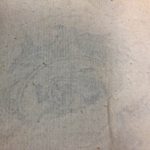
Fig. 6: The watermark on the inside cover of the book.
Holding the pages up to the light, the chain and cross lines become visible with the chain lines running vertical. The impress of the letters can be seen on most of the pages and can clearly be felt by running fingers over the letters. It is an odd feeling as most books these days have very smooth pages, but it is not unpleasant. Additionally, on the last page there is a bit of bleeding from the ink on the previous. (Fig. 7)
The book contains both signatures and page numbers. The fact that there is pagination also speaks to the fact that this book was printed in the 18th century, and towards the earlier days of the hand-press period only foliation (use of signatures) marked the pages in a book. The last page is 423 and the last signature I found is Ee2 which can be found in the direction line of page 411. Counting leaves in a signature told me that each gathering holds 4 leaves and eight pages of text.

Fig. 7: This is the last page in the book and the page previously has left traces of it’s text.
Furthermore, I made note of several things of interest including pictures, tears, examples where one could see the stitching, and even two cancellanda. For example, on the page denoted with signature A2, the sheet of paper used was not exact and you can see the feathering at the end of the sheet. (Fig. 8)A small tear exists on page twenty-two, and there is a series of small holes that appear on the inner margin of pages 154-164. However, I do not believe them to be instances of stab-stitching for they only appear on these pages, are not quite close enough to the spine, are irregular in size and shape, and this is the only place in the book that I found them.
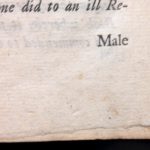
Fig. 8: Signature A2 where the edge of the page is feathered. Also known as deckled.
Examples where one can see the stitching of the gatherings exists on page 169 (Fig. 9), which is also the spot of one of the cancellandum (Fig. 10) , and again between pages 184-185. The other cancellandum is between pages 146-147. Rather than a page being sown in, re-inked, or having new paper pasted over, these pages have been cut out.
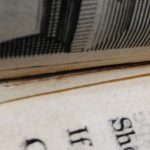
Fig. 9: An example of where the stitching of the gatherings shows.
Analysis:
With all of this data, it now becomes possible to answer a series of questions concerning the making of Poems. Selections. The first thing to discuss is the binding, which is in alright condition. There is definite evidence of wear along the spine where the spine meets the cover boards and the leather is not only beginning to crackle along the spine, but it is also covered in darker splotches, a sign of age. This is the original binding for the book as far as I can tell. The inner margins of the pages have not been tampered with, I see no signs of the book having been rebound at any point, and the wear on the binding suggests that it is as old as the book.
Of course, there is then the paper to examine. In this instance, the paper is of a type known as laid paper, with vertical chain lines and horizontal cross lines. All of the folds in this book have been trimmed and the edges have been cut. The only evidence I found of the deckling that one gets with laid paper is on signature A2 at the end of the tail margin. I did find a complete watermark on the inside cover of the book, but that is the only watermark I found. It is possible I missed other watermarks, but I looked through several signatures and did not find another. In addition to the page numbers, the book contains signatures in the direction line written in the usual pattern: uppercase letters, numbers, lowercase letters, numbers, one uppercase and one lowercase, and so on. The usual letters of I/J and W/V are skipped in order to avoid confusion.
With all of this information (4 leaves per gathering, vertical chain lines, and a book height of 20 cm), I believe that this book was printed in octavo format. This may also explain why it was hard for me to find a second watermark as watermarks are found at the head of the spine fold when the paper sheets are imposed in octavo format. Depending on how the book was bound, the watermarks may be too close to the spine for me to see properly. In addition, with 423 pages of text and eight pages of text per sheet of paper, I think that at least 56 sheets of paper went into the making of this book, at least where the actual poems are considered. With the endpapers and the preface added in, I think that there must be at least another 3-6 sheets bringing the total to somewhere between 59-62 sheets of paper.
Lastly, this book does include some images such as an illustration of the author (Fig. 11) and a picture representing his death at the end of the preface. (Fig. 12) Several other images of friends/family who he wrote poems for are included as well. All of these images seem to have been folded into the book or else sown in very tightly as I could not see any indication that they had been added in another manner.
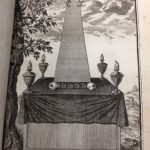
Fig. 12: The picture at the end of the preface containing the author’s life.

Fig. 11: The portrait of the author included at the start of the preface.
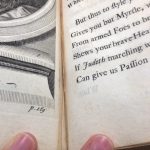
Fig. 10: An example of a cancellandum where the page was simply cut out.
Conclusion:
All in all, I found this to be an interesting and informative exercise that forced me to look at books in a different light. While a part of me has always treated books as material objects in a sense (I am definitely not in the Kindle camp), this exercise made me consider a book almost as solely a physical object without a lot of regard to the meaning of the text within it.
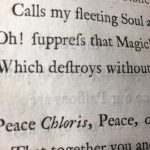
Fig. 15: An up close look at the impress of the letters on the previous page.
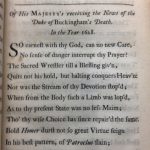
Fig. 15: An example of a typical page in the book. includes the header and the direction line (signature and catchword).

Fig. 14: The table of contents.

Fig. 13: The starting page to the preface that shows off some of the different font types.

